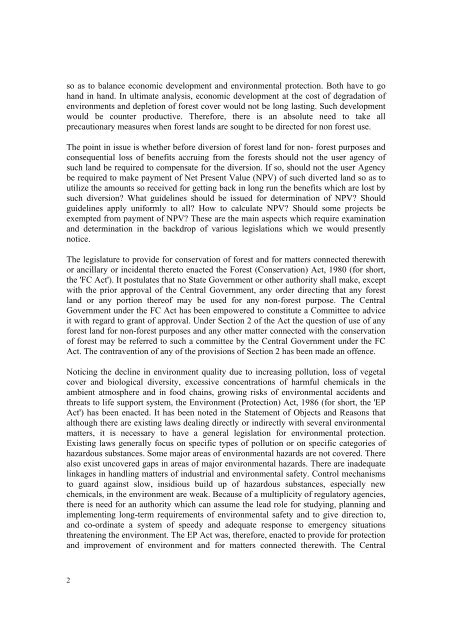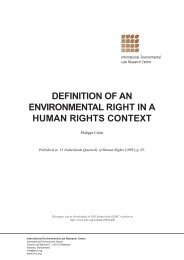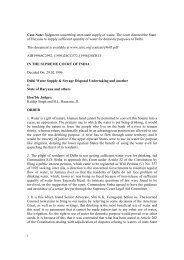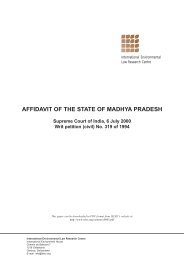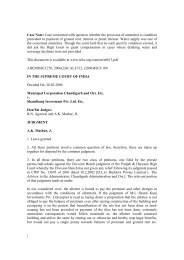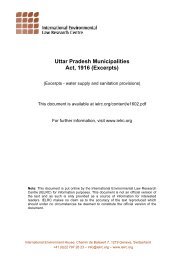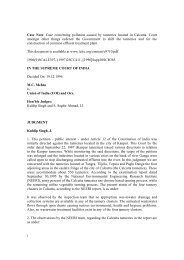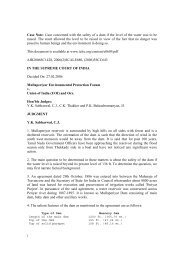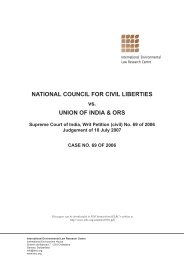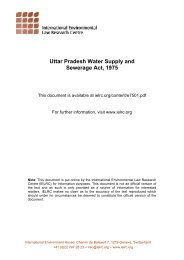T.N. Godavarman Thirumulpad v. Union of India - International ...
T.N. Godavarman Thirumulpad v. Union of India - International ...
T.N. Godavarman Thirumulpad v. Union of India - International ...
Create successful ePaper yourself
Turn your PDF publications into a flip-book with our unique Google optimized e-Paper software.
so as to balance economic development and environmental protection. Both have to gohand in hand. In ultimate analysis, economic development at the cost <strong>of</strong> degradation <strong>of</strong>environments and depletion <strong>of</strong> forest cover would not be long lasting. Such developmentwould be counter productive. Therefore, there is an absolute need to take allprecautionary measures when forest lands are sought to be directed for non forest use.The point in issue is whether before diversion <strong>of</strong> forest land for non- forest purposes andconsequential loss <strong>of</strong> benefits accruing from the forests should not the user agency <strong>of</strong>such land be required to compensate for the diversion. If so, should not the user Agencybe required to make payment <strong>of</strong> Net Present Value (NPV) <strong>of</strong> such diverted land so as toutilize the amounts so received for getting back in long run the benefits which are lost bysuch diversion? What guidelines should be issued for determination <strong>of</strong> NPV? Shouldguidelines apply uniformly to all? How to calculate NPV? Should some projects beexempted from payment <strong>of</strong> NPV? These are the main aspects which require examinationand determination in the backdrop <strong>of</strong> various legislations which we would presentlynotice.The legislature to provide for conservation <strong>of</strong> forest and for matters connected therewithor ancillary or incidental thereto enacted the Forest (Conservation) Act, 1980 (for short,the 'FC Act'). It postulates that no State Government or other authority shall make, exceptwith the prior approval <strong>of</strong> the Central Government, any order directing that any forestland or any portion there<strong>of</strong> may be used for any non-forest purpose. The CentralGovernment under the FC Act has been empowered to constitute a Committee to adviceit with regard to grant <strong>of</strong> approval. Under Section 2 <strong>of</strong> the Act the question <strong>of</strong> use <strong>of</strong> anyforest land for non-forest purposes and any other matter connected with the conservation<strong>of</strong> forest may be referred to such a committee by the Central Government under the FCAct. The contravention <strong>of</strong> any <strong>of</strong> the provisions <strong>of</strong> Section 2 has been made an <strong>of</strong>fence.Noticing the decline in environment quality due to increasing pollution, loss <strong>of</strong> vegetalcover and biological diversity, excessive concentrations <strong>of</strong> harmful chemicals in theambient atmosphere and in food chains, growing risks <strong>of</strong> environmental accidents andthreats to life support system, the Environment (Protection) Act, 1986 (for short, the 'EPAct') has been enacted. It has been noted in the Statement <strong>of</strong> Objects and Reasons thatalthough there are existing laws dealing directly or indirectly with several environmentalmatters, it is necessary to have a general legislation for environmental protection.Existing laws generally focus on specific types <strong>of</strong> pollution or on specific categories <strong>of</strong>hazardous substances. Some major areas <strong>of</strong> environmental hazards are not covered. Therealso exist uncovered gaps in areas <strong>of</strong> major environmental hazards. There are inadequatelinkages in handling matters <strong>of</strong> industrial and environmental safety. Control mechanismsto guard against slow, insidious build up <strong>of</strong> hazardous substances, especially newchemicals, in the environment are weak. Because <strong>of</strong> a multiplicity <strong>of</strong> regulatory agencies,there is need for an authority which can assume the lead role for studying, planning andimplementing long-term requirements <strong>of</strong> environmental safety and to give direction to,and co-ordinate a system <strong>of</strong> speedy and adequate response to emergency situationsthreatening the environment. The EP Act was, therefore, enacted to provide for protectionand improvement <strong>of</strong> environment and for matters connected therewith. The Central2


